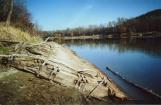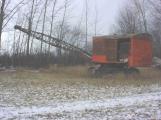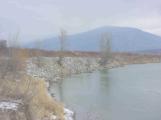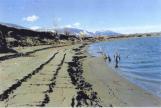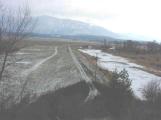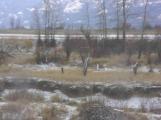27
This is the discharge channel for the south end of the Reclamation Dyking District; the photo was taken from just above the concrete enclosure for the culverts. It was probably, many years ago, a channel of the Kootenay River, though some people we talked to believe it was dug, or at least widened, by the Alberta and British Columbia Exploration Company. Today, it spills into the marshy area known as French's Slough, which runs up the west side of Nick's Island and empties into the main channel of the Kootenay River.29
From the pumphouse, we continued south, driving across the original Piper farm. The Pipers were among the group of farmers that came to the Creston Valley in 1929, and stayed despite the recurring floods. Cyril stopped to show us this dragline, which was - and still is, occasionally - used for a variety of dyke construction and repair work throughout the Reclamation Dyking District. It's a Northwestern, similar to the machines that built many of the dykes throughout the Creston Valley.31
We turned onto Hanson Road, heading south-east along the top of Dutch's Ridge. This is the natural high ground that marked the southern limit of dyking in 1934, and connects with the dyke at the pumphouse we visited a few minutes earlier. Hanson Road leads onto a dyke along the west short of the Kootenay River, and Cyril stopped on this dyke to point out the rip-wrap: rocks piled up on the outside of the dykes, to prevent erosion of the dykes themselves. This, and another technique called set-back, are needed to counteract the more frequent fluctuations in the river since Libby Dam was built.33
Cyril brought in this photo of the Kootenay River at low water. The ridges in the mud are caused by frequent fluctuations in the water level. Libby Dam, several times a year, will release water from its reservoir for a variety of reasons, and, although the rise is nowhere near the height of spring floods before Libby Dam was built, it causes enormous damage to the dykes. Each time the water rises, it softens the dykes, and when it falls, the softened walls slough away. Without the rip-wrap and set-backs, the dykes would be in very poor condition.34
Remains of a wooden barge alongside the Kootenay River south of Creston.April, 2000
Kootenay River, near Creston, BC
